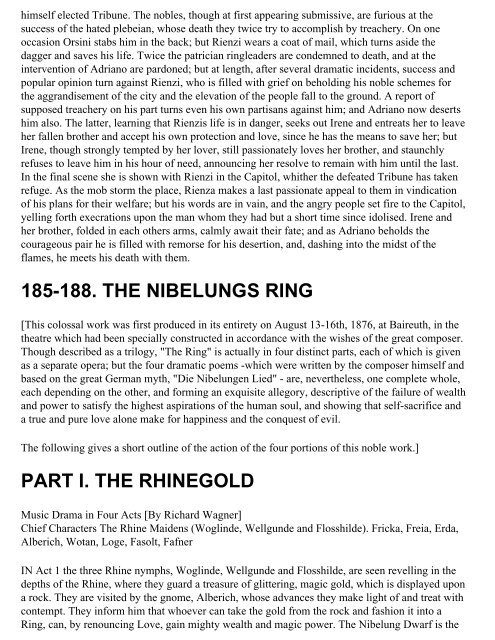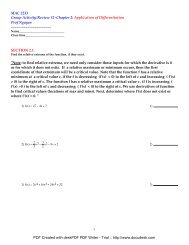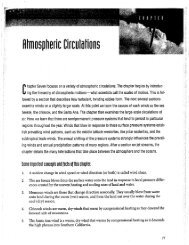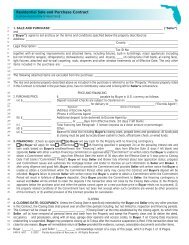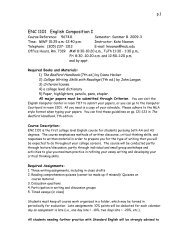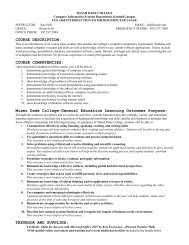Opera Plots I - MDC Faculty Home Pages
Opera Plots I - MDC Faculty Home Pages
Opera Plots I - MDC Faculty Home Pages
You also want an ePaper? Increase the reach of your titles
YUMPU automatically turns print PDFs into web optimized ePapers that Google loves.
himself elected Tribune. The nobles, though at first appearing submissive, are furious at the<br />
success of the hated plebeian, whose death they twice try to accomplish by treachery. On one<br />
occasion Orsini stabs him in the back; but Rienzi wears a coat of mail, which turns aside the<br />
dagger and saves his life. Twice the patrician ringleaders are condemned to death, and at the<br />
intervention of Adriano are pardoned; but at length, after several dramatic incidents, success and<br />
popular opinion turn against Rienzi, who is filled with grief on beholding his noble schemes for<br />
the aggrandisement of the city and the elevation of the people fall to the ground. A report of<br />
supposed treachery on his part turns even his own partisans against him; and Adriano now deserts<br />
him also. The latter, learning that Rienzis life is in danger, seeks out Irene and entreats her to leave<br />
her fallen brother and accept his own protection and love, since he has the means to save her; but<br />
Irene, though strongly tempted by her lover, still passionately loves her brother, and staunchly<br />
refuses to leave him in his hour of need, announcing her resolve to remain with him until the last.<br />
In the final scene she is shown with Rienzi in the Capitol, whither the defeated Tribune has taken<br />
refuge. As the mob storm the place, Rienza makes a last passionate appeal to them in vindication<br />
of his plans for their welfare; but his words are in vain, and the angry people set fire to the Capitol,<br />
yelling forth execrations upon the man whom they had but a short time since idolised. Irene and<br />
her brother, folded in each others arms, calmly await their fate; and as Adriano beholds the<br />
courageous pair he is filled with remorse for his desertion, and, dashing into the midst of the<br />
flames, he meets his death with them.<br />
185-188. THE NIBELUNGS RING<br />
[This colossal work was first produced in its entirety on August 13-16th, 1876, at Baireuth, in the<br />
theatre which had been specially constructed in accordance with the wishes of the great composer.<br />
Though described as a trilogy, "The Ring" is actually in four distinct parts, each of which is given<br />
as a separate opera; but the four dramatic poems -which were written by the composer himself and<br />
based on the great German myth, "Die Nibelungen Lied" - are, nevertheless, one complete whole,<br />
each depending on the other, and forming an exquisite allegory, descriptive of the failure of wealth<br />
and power to satisfy the highest aspirations of the human soul, and showing that self-sacrifice and<br />
a true and pure love alone make for happiness and the conquest of evil.<br />
The following gives a short outline of the action of the four portions of this noble work.]<br />
PART I. THE RHINEGOLD<br />
Music Drama in Four Acts [By Richard Wagner]<br />
Chief Characters The Rhine Maidens (Woglinde, Wellgunde and Flosshilde). Fricka, Freia, Erda,<br />
Alberich, Wotan, Loge, Fasolt, Fafner<br />
IN Act 1 the three Rhine nymphs, Woglinde, Wellgunde and Flosshilde, are seen revelling in the<br />
depths of the Rhine, where they guard a treasure of glittering, magic gold, which is displayed upon<br />
a rock. They are visited by the gnome, Alberich, whose advances they make light of and treat with<br />
contempt. They inform him that whoever can take the gold from the rock and fashion it into a<br />
Ring, can, by renouncing Love, gain mighty wealth and magic power. The Nibelung Dwarf is the


